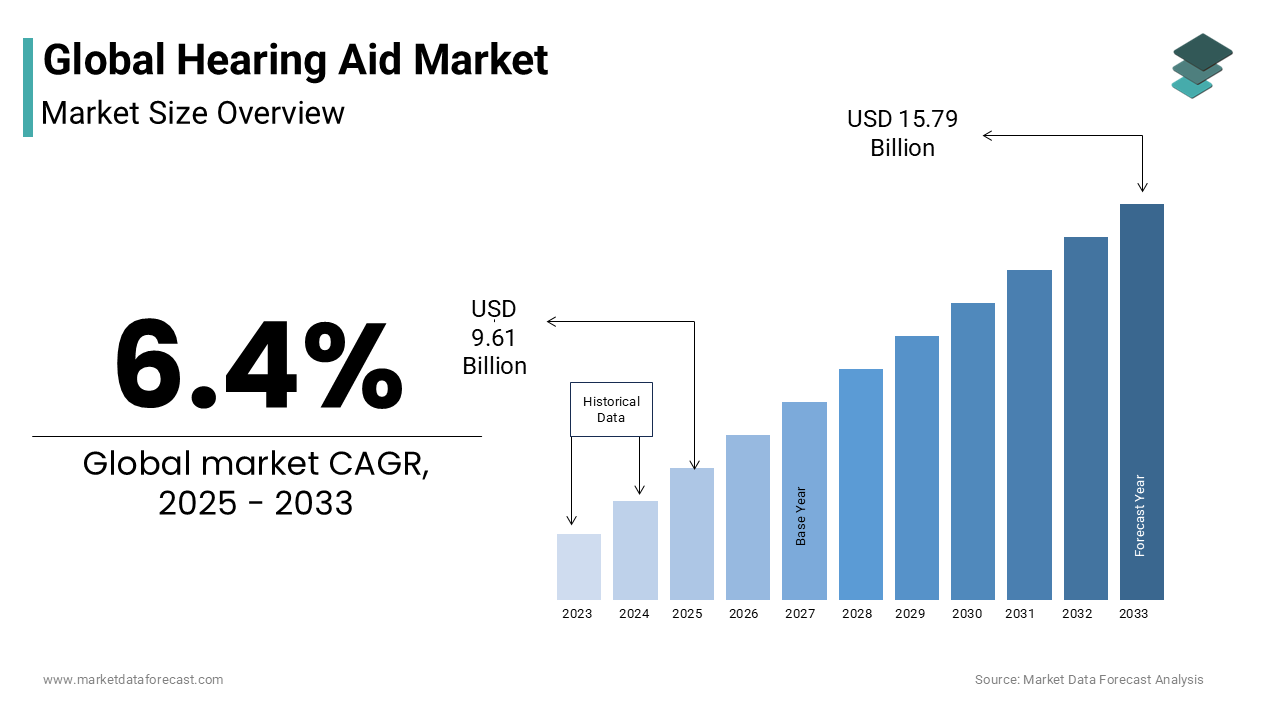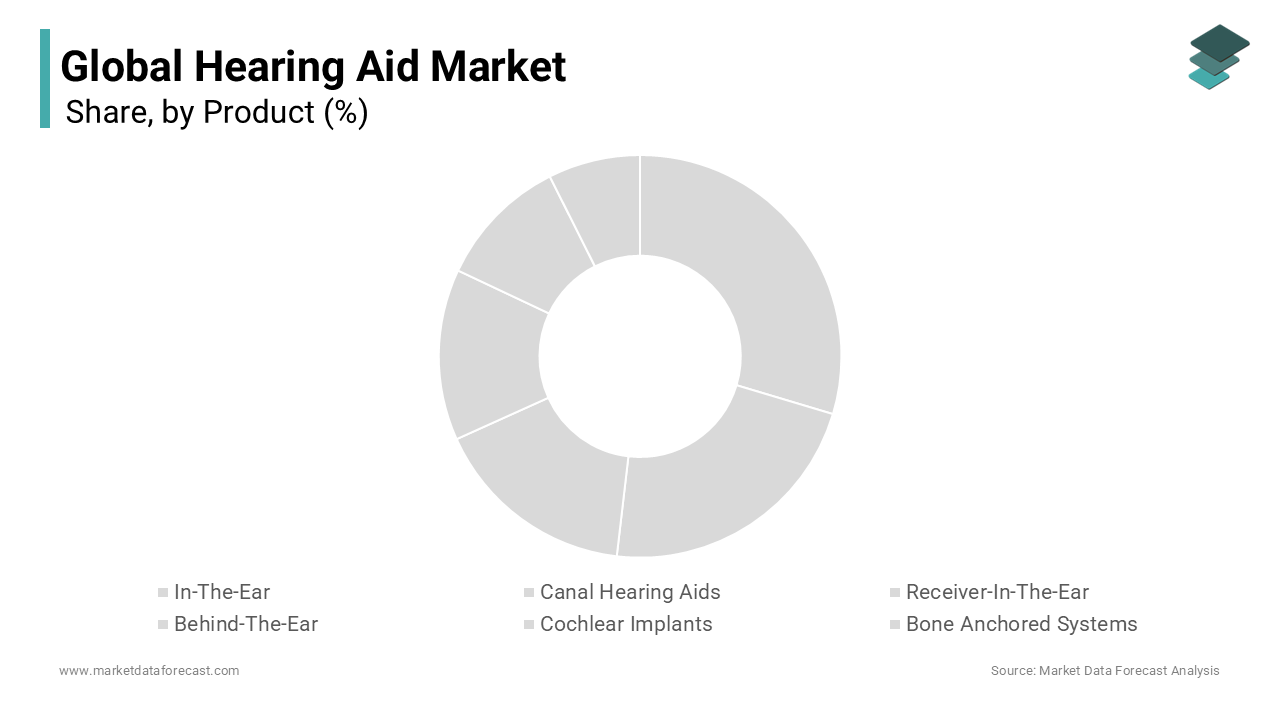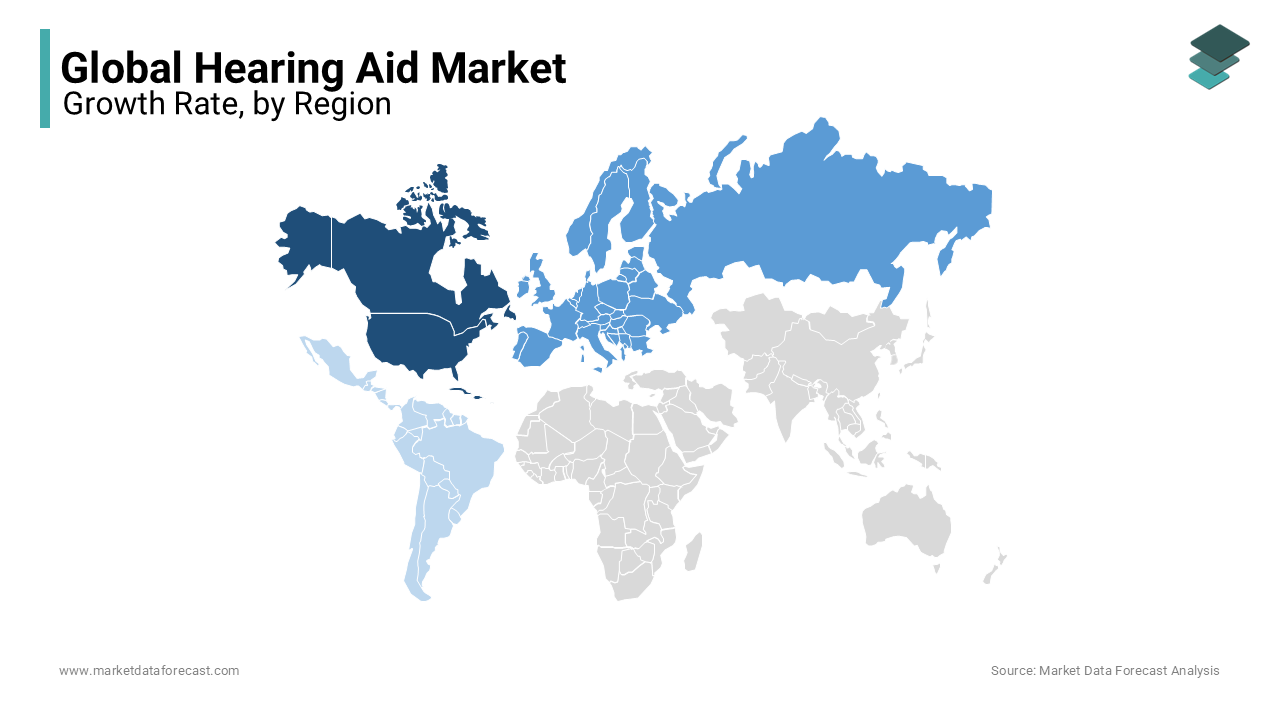Global Hearing Aid Market Size, Share, Trends and Growth Analysis Report - Segmented By Hearing Loss, Product (In-The-Ear, Canal Hearing Aids, Receiver-In-The-Ear, Behind-The-Ear, Cochlear Implants and Bone Anchored Systems), End-User & Region (North America, Europe, Asia-Pacific, Latin America, Middle East and Africa) - Industry Analysis From 2025 to 2033
Global Hearing Aid Market Size
The global hearing aid market was valued at USD 9.03 billion in 2024. As per our analysis report, the size of the global hearing aid market is projected to reach USD 15.79 billion by 2033 from USD 9.61 billion in 2025. As per our recent research report, this market registers a CAGR of 6.4% during the forecast period.

Hearing loss patients can mostly benefit from using hearing aid devices. These devices allow hearing loss patients to actively participate in their daily activities by using this small electronic device. The rapid adoption of advanced technologies in the healthcare system is adding scope for the growth of the hearing aid market. Nowadays, over-the-counter hearing aids are trending in both developed and emerging countries. People can go directly to the shops and buy hearing aids without even consulting a healthcare health professional. Hearing loss is a most common factor for elderly people, and these devices may enhance their lifestyle so that they can do daily activities at ease without any difficulties. Even adults are facing serious hearing loss problems across the world, and this is constantly allowing researchers to launch innovative devices to promote a better lifestyle for those in need. Currently, there are several ongoing research activities to develop highly accurate hearing aids that can improve understanding through speech signals. Appreciable funds are needed to launch the best suitable hearing aids for children with high accuracy and elevate the growth rate of the market. According to the National Library of Medicine, around 10% of the world's population suffers from hearing loss, and the demand to do research activities on launching hearing aid devices with advanced factors is increasing every year.
MARKET DRIVERS
The growing patient population suffering from hearing loss is one of the major factors driving the growth of the hearing aid market.
In 2019, 466 million people had hearing loss disabilities (where 34 million are children), and it is estimated to reach 900 million by 2050. According to WHO, 5% of the world population suffers from hearing loss problems, of which 32 million are adults and 34 million are children. In the U.K., 10 million people have various forms of hearing impairment. In America, 1 out of 5 teens experience hearing loss issues and show interest in proper education. The Individuals with Disabilities Education Act (IDEA) ensures hearing loss students get appropriate education and accommodations. Mild hearing loss may also cause a child to miss 50% of classroom discussions. Regularly, 10% of Americans are affected by Tinnitus, where 16 million seek medical assistance. In the United States, in every 1000 children, 2 to 3 suffered from hearing loss in one or both ears in 2016, according to NIDCD. Also, around 15% of adults aged above 18 report the same issues every year. People in the 60-69 age group are more likely to have hearing loss.
Technological developments in hearing aids and the increasing global aged population are aiding the global hearing aid market growth.
The ever-growing trend towards customized implants is also an attribute propelling the growth of the hearing aid market. In developing countries, preventable medical problems are often the leading cause of hearing loss, and infectious diseases such as rubella and syphilis can lead to congenital hearing loss. Besides, pregnancy complications can lead to hearing loss in the infant, and the increasing frequency of hearing loss and hearing loss problems among the population, has led to the sale of numerous hearing aids on the market.
Furthermore, the rising noise pollution around the globe significantly impacts people's hearing skills. The noise emissions in heavy-duty industries, and even public carnivals, will damage adult hearing capacity, driving higher demand for the hearing aid market. Because of the noisy drilling and dismantling jobs, hearing aids are also higher among construction workers.
MARKET RESTRAINTS
Lack of proper knowledge about the use of hearing aids in remote areas is quite a restraining factor for the hearing aid market. Most people in remote areas are unaware of the advanced technological developments in healthcare due to fewer government campaigns. People face difficulties hearing loud background noises, which pose huge discomfort to the actual sounds. People who start using hearing aids take time to understand the speech when the background noise is huge. This factor is a major challenge for developers in reducing undesirable distortions and enhancing speech intelligibility.
High cost of the highly accurate hearing aids manufactured with the latest technologies can limit the scope of the market in the future. People in rural areas could not afford these devices due to its high cost. Top companies are making huge research activities to develop a device within the affordable price for the common people.
REPORT COVERAGE
|
REPORT METRIC |
DETAILS |
|
Market Size Available |
2024 to 2033 |
|
Base Year |
2024 |
|
Forecast Period |
2025 to 2033 |
|
Segments Covered |
By Product, Hearing Loss, End-User, and Region |
|
Various Analyses Covered |
Global, Regional and Country Level Analysis, Segment-Level Analysis, Drivers, Restraints, Opportunities, Challenges; PESTLE Analysis; Porter's Five Forces Analysis, Competitive Landscape, Analyst Overview of Investment Opportunities |
|
Regions Covered |
North America, Europe, Asia Pacific, Latin America, the Middle East, and Africa |
|
Market Leaders Profiled |
GN Store Nord A/S (Denmark), Cochlear Limited (Australia), MED-EL (Austria), SeboTek Hearing Systems, Starkey Hearing Technologies, Inc. (U.S.), Widex (Denmark), William Demant Holding A/S (Denmark), Sivantos Pte. Ltd. (Singapore), Sonova (Switzerland) and Zounds Hearing, Inc. (U.S.). |
SEGMENTAL ANALYSIS
By Product Insights

Based on the product, the in-the-ear segment is estimated to hold the most significant share of the global hearing aid market during the forecast period owing to the increasing number of people suffering from hearing loss problems.
The canal hearing aids market is predicted to register healthy growth during the forecast period due to the growing awareness among people towards the availability of different devices.
Receiver-in-the-ear and behind-the-ear segments are expected to grow in foreseen years. The rise in R&D activities in developed countries is elevating the growth of these segments.
The cochlear implants segment is also likely to have a surge in growth rate in the coming years with the rise in the world's aging population.
On the other hand, the bone-anchored hearing aid market is expected to grow at a moderate growth rate during the forecast period.
By Hearing Loss Insights
The sensorineural hearing loss segment is the most lucrative segment based on hearing loss due to a rise in hearing loss-related diseases. In addition, growing support from both public and private organizations boosts the demand for this market. Furthermore, escalating healthcare expenditure significantly influences the market's growth rate.
The conductive segment will hit the highest CAGR during the forecast period. Adopting the latest technologies in healthcare positively impacts the market's growth. In addition, the rise in the number of screening and diagnosing tests in newborn babies is accelerating the growth rate of this market.
By End-User Insights
The adult segment has a dominant hearing aid market share, whereas the pediatrics segment holds the highest CAGR in the forecast period. Initiative steps by the government in concern towards ordinary people are anticipated to leverage the market's demand. In addition, growing hearing loss defects in newborn babies are considered to elevate the need for the hearing aid market.
REGIONAL ANALYSIS

Geographically, the North American region accounted for the dominating share of the worldwide market in 2024 and is estimated to continue dominating throughout the forecast period owing to the continually growing economy. In addition, the rise in the adoption of the latest technology, the launch of innovative products, and the increasing prevalence of developing cost-effective devices are propelling the regional market growth.
Europe is forecasted to hold a substantial share worldwide in 2024. It is expected to grow at a healthy CAGR in the coming years owing to the growing aging population and the adoption of technological advancements in manufacturing advanced hearing aids.
The Asia-Pacific region is one of the most promising regions globally, and it is estimated to have the fastest growth in the foreseen years. India and China are the major countries that lead market shares in this region. The increasing population is undoubtedly a key factor for the market to grow. Creating awareness among the people living in rural areas through campaigns and digital advertisements is fuelling the market’s growth rate in APAC. In addition, the prevalence of e-commerce is also surging the growth of the market.
Latin America is anticipated to grow at a steady CAGR and MEA is expected to hold a moderate share of the worldwide market in the coming years.
KEY MARKET PLAYERS
Some of the significant manufacturers playing a prominent role in the global hearing aid market profiled in this report are GN Store Nord A/S (Denmark), Cochlear Limited (Australia), MED-EL (Austria), SeboTek Hearing Systems, Starkey Hearing Technologies, Inc. (U.S.), Widex (Denmark), William Demant Holding A/S (Denmark), Sivantos Pte. Ltd. (Singapore), Sonova (Switzerland) and Zounds Hearing, Inc. (U.S.).
RECENT MARKET HAPPENINGS
- In 2024, GN Store Nord A/S launched new styles of hearing aids that offer the next era of connectivity with at least technology into the family of ReSound Nexia. The new style of the hearing aid is top-rated in sound quality and hearing in noise. This style of product overcomes all the challenges of traditional hearing aid devices. This device is excellent in providing speech by minimizing background noise, and it can work with Bluetooth connectivity. GN Store Nord A/S company has never failed to overcome the challenges of misperceptions about hearing loss and hearing aids from past years.
- In March 2020, Widex, a leading hearing aid manufacturer, invented a new device to address tiny and artificial hearing aid equipment sounds. This device works effectively by eliminating unnatural sounds and exchanging information between the microphone and the receiver.
- In March 2019, Sonova and Semtech jointly introduced a new radio system that will play a key role in manufacturing new-generation hearing aids. In the 2.4Hz band, this system can enable multiple protocols.
DETAILED SEGMENTATION OF THE GLOBAL HEARING AID MARKET INCLUDED IN THIS REPORT
This research report on the global hearing aid market has been segmented and sub-segmented based on the product, hearing loss, end-user, and region.
By Product
- In-The-Ear
- Canal Hearing Aids
- Receiver-In-The-Ear
- Behind-The-Ear
- Cochlear Implants
- Bone Anchored Systems
By Hearing Loss
- Sensorineural
- Conductive
By End User
- Adults
- Pediatrics
By Region
- North America
- Europe
- Asia-Pacific
- Latin America
- The Middle East and Africa
Frequently Asked Questions
Which region led the hearing aid market in 2024?
The European region accounted for the most significant share of the global hearing aid market in 2024.
How much is the global hearing aid market going to be worth by 2033?
The global hearing aid market size is estimated to grow USD 15.79 billion by 2033.
Which segment by end-user is projected to lead the hearing aid market in the coming years?
Based on the end-user, the adult segment is estimated to dominate the hearing aid market from 2025 to 2033.
Related Reports
Access the study in MULTIPLE FORMATS
Purchase options starting from $ 2500
Didn’t find what you’re looking for?
TALK TO OUR ANALYST TEAM
Need something within your budget?
NO WORRIES! WE GOT YOU COVERED!
Call us on: +1 888 702 9696 (U.S Toll Free)
Write to us: [email protected]
